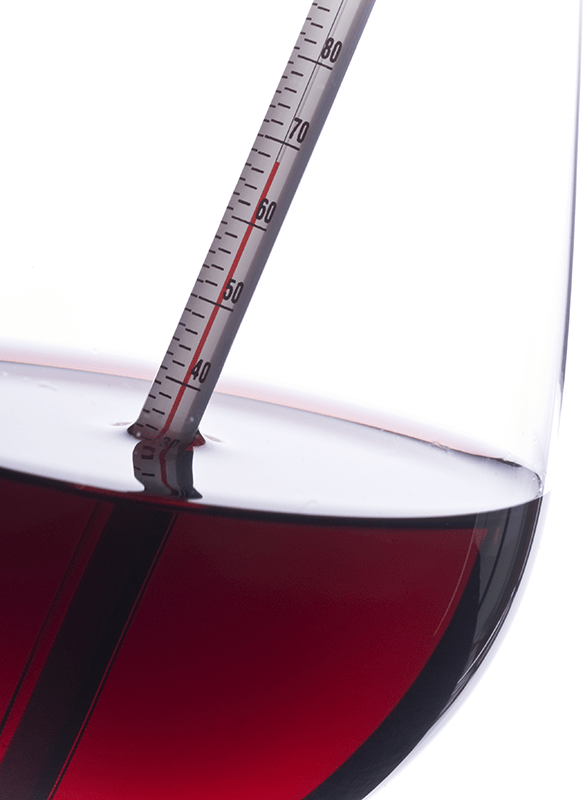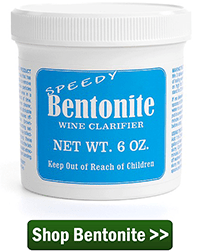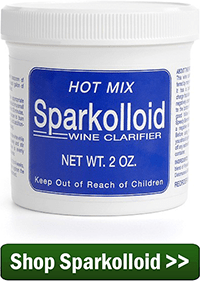 I keep my wine at 72-75 when fermenting. Do I need to keep it at those temps when clearing?
I keep my wine at 72-75 when fermenting. Do I need to keep it at those temps when clearing?
Name: Ron M.
State: MI
—–
Hello Ron,
Great question! What is the best temperature for clearing wine?
Keeping your wine must at 70°F to 75°F is perfect for maintaining a vigorous fermentation. The wine yeast is very comfortable at this temperature range. However, once the fermentation has completed there is no reason to maintain this particular temperature range. The only reason for doing so is to keep the yeast happy so that they can do their job.
In fact, right after the fermentation the ideal temperature would be just above freezing. A range of 32°F to 35°F would be most beneficial to the wine for a number of reason:
- It would allow proteins such as yeast, tannin, etc. to drop out of the wine efficiently and thoroughly, leaving behind a crispy clear wine.
- It would cold stabilize the wine, meaning that any excess tartaric acid that may be in the wine would precipitate out of the wine as little flaky crystals. By enticing the wine to do this now, you won’t have to worry about these flakes forming later, after the wine has been bottled.
- It would also keep the potential for any spoilage of the wine down to an bare minimum. Various little nasties like mold and bacteria will not thrive at such an inhospitable temperature.
While just above freezing my be the best temperature for clearing wine, there are two major downfalls with this Utopian temperature:
- It’s not very practical. This would usually mean dedicating an entire refrigerator to age the wine, and for winemakers producing 10, 20, 50 gallons, it would be almost impossible.
- The wine won’t age. Such a cool temperature would not allow the wine to age properly. Actually, it would suspend any aging activity to a undetectable minimum. Basically, your wine would never mature at this temperature. Most wine professionals agree that the optimal temperature for aging is 55°F.
So to answer your question, you do not need to keep your wine at 70°F to 75°F after the fermentation, but you do want to keep it cooler, not warmer. How cool is another question. The optimal thing would be to bring it down to above freezing for a few days, to cold stabilize it. Then bring the temperature up to 55°F for aging and wine bottle storage.
 It’s completely understandable if you – as a home winemaker – are not able to do such a feat. Some things are just not practical. To that I say, do the best you can. Don’t store your wine in the hot closet. Think of a cooler place to keep it, like in a basement floor, etc. Just keep the wine out of the heat.
It’s completely understandable if you – as a home winemaker – are not able to do such a feat. Some things are just not practical. To that I say, do the best you can. Don’t store your wine in the hot closet. Think of a cooler place to keep it, like in a basement floor, etc. Just keep the wine out of the heat.
I hope this information helps you out. Now that you know the best temperature for clearing wine, realize that if all you can do is keep the wine in the 70°’s all the time, it wouldn’t ruin the wine or anything like that. I’m just giving you the optimal situation, so you can know what to strive for within the constraints of your situation.
Happy Winemaking,
Ed Kraus
—–
Ed Kraus is a 3rd generation home brewer/winemaker and has been an owner of E. C. Kraus since 1999. He has been helping individuals make better wine and beer for over 25 years.

For what it’s worth, I’ve had success with filling a big tote with water and letting it sit in there for a few days. I try to keep frozen water bottles (or old milk jugs if I have the space) in the freezer and whenever the ice melts I’ll just toss in another block.
I just made a wine cellar (room) in my basement but the temp stays between 68- 70 (ish) it doesn’t get that cool. Will this ruin my wine?
I hope not, there really isn’t anywhere else to keep my stock.
Julie, no that temperature is not going to ruin you wine at all. Just realize that the warmer the storage temperature the faster the wine will age. This is fine if you are waiting for it to mature, but its bad if you leave the wine sit at this temperature beyond maturity. The wine will start to loose flavor. Your can read more about this at the following link:
Wine Bottle Storage Temperature
http://www.eckraus.com/wine-making-bottle-storage
About three weeks ago I added Sparkolloid to my three gallon jugs of wine to clarify it. I had previously racked it twice after fermentation was complete. I have noticed several small white flakes suspended along the sides of the jugs. Will these white flakes finally drop down to the bottom so I can rack and bottle?
Chuck, white flakes in the wine could indicate tartaric acid precipitation. The article below will discuss this further and tell you how to treat the wine.
Temperature Stability
http://eckraus.com/wine-making-stabilization/
I have a 3 gallon Fastferment Conical. I can stick the whole conical into a small Marvel fridge with a temperature controller on it. I use it for lagering my beer. Would this process work.
1. Set temperature to 34 degrees for 5 days
2. Raise temp on day 6 to 55 degrees.
3. Bottle when completely clear.
I used a 1 gallon Master Vintner kit that included kieselsol, potassium sorbate and chiltosan in it. Everything was added and I am about a week into the chi to San and it’s clearimg. Every week I clear the sediment from the collection ball.
Any recommendations?
My father has been making homemade Californian grapes wine for 65 years. Being from northern Italy they have traditions about racking wine. For example on the second and 3rd racking if it’s cloudy or raining they will wait for a sunny day. So my question is does a rainy or cloudy weather day affect wine if you rack it on bad weather?
Giorgio, we have never heard of the weather affecting the wine when rack.
Giorgio, my family is from southern Italy and I was also told about the relationship of weather and racking days, also the relationship of racking and the phase of the moon. I did a experiment myself to see if any difference is found. I racked one batch on a rainy weekday and marked the container. I then racked the second half of the batch on a clear sunny day just 3 days later.I was surprised to discover the second batch matured to a clearer crisp wine. This was on red Cab/Sav, there maybe somethinng to the generations of making wine and accounting for weather conditions during the process. All the wine was same grapes same soring temp and conditions.